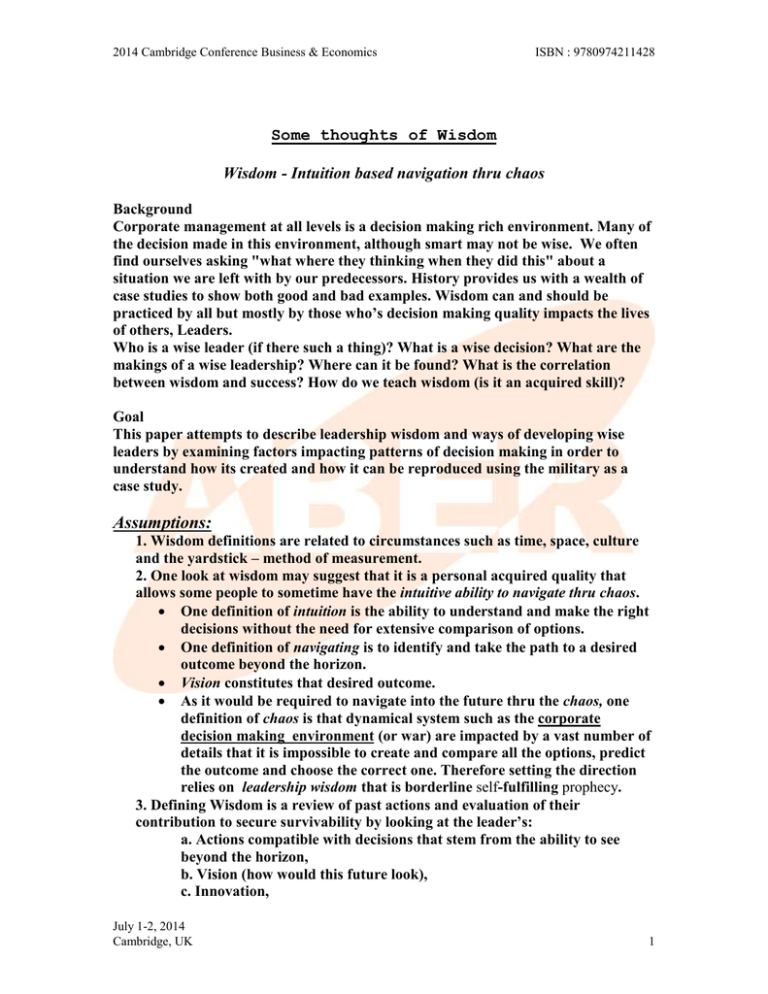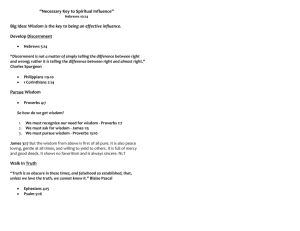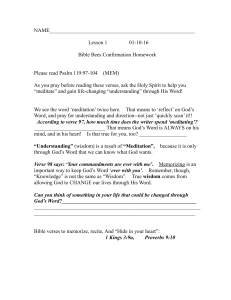Some Thoughts of Wisdom
advertisement

2014 Cambridge Conference Business & Economics ISBN : 9780974211428 Some thoughts of Wisdom Wisdom - Intuition based navigation thru chaos Background Corporate management at all levels is a decision making rich environment. Many of the decision made in this environment, although smart may not be wise. We often find ourselves asking "what where they thinking when they did this" about a situation we are left with by our predecessors. History provides us with a wealth of case studies to show both good and bad examples. Wisdom can and should be practiced by all but mostly by those who’s decision making quality impacts the lives of others, Leaders. Who is a wise leader (if there such a thing)? What is a wise decision? What are the makings of a wise leadership? Where can it be found? What is the correlation between wisdom and success? How do we teach wisdom (is it an acquired skill)? Goal This paper attempts to describe leadership wisdom and ways of developing wise leaders by examining factors impacting patterns of decision making in order to understand how its created and how it can be reproduced using the military as a case study. Assumptions: 1. Wisdom definitions are related to circumstances such as time, space, culture and the yardstick – method of measurement. 2. One look at wisdom may suggest that it is a personal acquired quality that allows some people to sometime have the intuitive ability to navigate thru chaos. One definition of intuition is the ability to understand and make the right decisions without the need for extensive comparison of options. One definition of navigating is to identify and take the path to a desired outcome beyond the horizon. Vision constitutes that desired outcome. As it would be required to navigate into the future thru the chaos, one definition of chaos is that dynamical system such as the corporate decision making environment (or war) are impacted by a vast number of details that it is impossible to create and compare all the options, predict the outcome and choose the correct one. Therefore setting the direction relies on leadership wisdom that is borderline self-fulfilling prophecy. 3. Defining Wisdom is a review of past actions and evaluation of their contribution to secure survivability by looking at the leader’s: a. Actions compatible with decisions that stem from the ability to see beyond the horizon, b. Vision (how would this future look), c. Innovation, July 1-2, 2014 Cambridge, UK 1 2014 Cambridge Conference Business & Economics ISBN : 9780974211428 d. Experience, that is based on combining diverse knowledge and; e. Sticking to core values that express the essence of the organization’s survivability. 4. Wisdom requires actions that its consequences will only be seen beyond the person’s horizon and can imply great ego, wisdom or both it also requires a high degree of emotional control. 5. As all decisions are made based on limited information under current day restrictions and the constraints of time it is the x factor that make them wise or not. That x factor is the decision maker’s intuitive ability to navigate thru chaos – the leader’s Wisdom. A wisdom yardstick – using the definitions of wisdom to evaluate events, the considerations for the decisions that led to them and rate their wisdom. In most cases wisdom can only be measured by comparison to the road not taken, a speculation of what would happen had we taken a different path or comparison to others that have taken a different rout. In both cases the comparison is speculative at best as the chaotic amount of circumstances options and details prevent us from getting a reliable answer. A look at a path to wisdom – leadership creation the in the military as case study: As stated, if wisdom is attributed to an act by reflecting on the past now comes the question of how we predict what are the qualities of wise decision makers. As most decision makers have achieved the state of wisdom thru a process (Intuition based navigation thru chaos) we would attribute it to the success of the process. There is an inherent conflict in the process of reaching the wisdom state as wise decisions are made by experienced leaders. The process of gaining experience includes a learning curve - that includes trying, learning what works and what doesn’t – failing, and learning from it. The military’s formula to address this process is a combination of: 1. Starting off with a “large” bank of candidates, continues education, 2. On going screening & selection, 3. Mentoring, 4. Training, 5. Allowing trail & error and, 6. Instilling and validating that the loyalty and core values (tribe, state, military or company) are ingrained in the leader’s soul so he always strives to secure the survivability of the organization. Great commitment, investment and continuity is required for the success of this program. The military’s deliberate way of creating wise leaders has a key ingredient for success. The acknowledgment of the presence of failure. It could be argued that the military’s goal is leadership creation and not wisdom. I agree that at the lower levels July 1-2, 2014 Cambridge, UK 2 2014 Cambridge Conference Business & Economics ISBN : 9780974211428 it is true but as the successful leaders climb to the top it is more the wisdom than the leadership quality that are sought after tested and refined. 1. By continuously screening its future leaders for the making of a leader Character, personality, charisma, core values and technical leadership skills. That is the threshold. 2. By the right combination of many levels of education at the right time, fieldwork, staff work and training. 3. By longevity in the system that allows: a. Diversified exposure to events and situations, b. Exposure and continues testing of their inner working to insure their core values are solid. c. Strong identification with the organization and commitment to its future. d. The ability to identify the ones who possess the relevant intuition and have perfected it. The ones who see beyond the tool of systematic processes and use it to leverage innovation. e. Be judged in the long term based on track record not just based on one immediate success. f. Be allowed to evolve. Longevity is a risky investment with great benefits. Risky because: 1. Not all participants in the program graduate. 2. It is an expensive program. 3. Like any other great idea if not carefully controlled it can backfire with deadly effects. 4. Those who do not rise to the level of wise leaders but the organization fails to remove cling to the process (which is only a tool) and drive the organization to mediocrity and destruction. Wisdom is not bestowed and many who walk the path (thru the military or other organizations) do not acquire this unique capacity. However the willingness of societies and organizations to invest in creating a cadre of people at the top echelon that have a high probability of being wise leaders sets them apart form the rest. One example of military deliberate leadership and wisdom creation is Gen. Mark A. Welsh III, Chief of the USAF. He is the first of his peers but likely a typical product of the system that build him and the likes of him. When the time comes there will be a cadre of Mark Welshes to choose from. July 1-2, 2014 Cambridge, UK 3 2014 Cambridge Conference Business & Economics ISBN : 9780974211428 General Welsh was born in San Antonio, Texas. He entered the Air Force in June 1976 as a graduate of the U.S. Air Force Academy. He has been assigned to numerous operational, command and staff positions. Prior to his current position, he was Commander, U.S. Air Forces in Europe. EDUCATION 1976 Bachelor of Science degree, U.S. Air Force Academy, Colorado Springs, Colo. 1984 Squadron Officer School, by correspondence 1986 Air Command and Staff College, by correspondence 1987 Master of Science degree in computer resource management, Webster University 1988 Army Command and General Staff College, Fort Leavenworth, Kan. 1990 Air War College, by correspondence 1993 National War College, Fort Lesley J. McNair, Washington, D.C. 1995 Fellow, Seminar XXI, Massachusetts Institute of Technology, Cambridge 1998 Fellow, National Security Studies Program, Syracuse University and John Hopkins University, Syracuse, N.Y. 1999 Fellow, Ukrainian Security Studies, John F. Kennedy School of Government, Harvard University, Cambridge, Mass. 2002 The General Manager Program, Harvard Business School, Harvard University, Cambridge, Mass. 2009 Fellow, Pinnacle Course, National Defense University, Fort Lesley J. McNair, Washington, D.C. 2009 Leadership at the Peak, Center for Creative Leadership, Colorado Springs, Colo. ASSIGNMENTS 1. August 1976 - July 1977, Student, undergraduate pilot training, Williams Air Force Base, Ariz. 2. July 1977- January 1981, T-37 Instructor Pilot and class commander, Williams AFB, Ariz. 3. January 1981 - May 1981, Student, fighter lead-in training, Holloman AFB, N.M. 4. May 1981 - August 1981, Student, A-10 training, Davis-Monthan AFB, Ariz. 5. August 1981 - May 1984, Instructor pilot, Flight Commander and wing standardization and evaluation Flight Examiner, 78th Tactical Fighter Squadron and 81st Tactical Fighter Wing, Royal Air Force Woodbridge, England 6. May 1984 - June 1987, Commander, Cadet Squadron 5, later, executive officer to the Commandant of Cadets, U.S. Air Force Academy, Colorado Springs, Colo. 7. June 1987 - June 1988, Student, Army Command and General Staff College, Fort Leavenworth, Kan. 8. June 1988 - October 1988, Student, F-16 conversion training, Luke AFB, Ariz. 9. October 1988 - July 1992, Operations Officer, 34th Tactical Fighter Squadron, later, Commander, 4th Tactical Fighter Squadron, Hill AFB, Utah 10. July 1992 - June 1993, Student, National War College, Fort Lesley J. McNair, Washington, D.C. July 1-2, 2014 Cambridge, UK 4 2014 Cambridge Conference Business & Economics ISBN : 9780974211428 11. June 1993 - June 1995, Chief, Defense and Space Operations Division, Operations Directorate (J3), Joint Staff, the Pentagon, Washington, D.C. 12. June 1995 - April 1997, Commander, 347th Operations Group, Moody AFB, Ga. 13. April 1997 - June 1998, Commander, 8th Fighter Wing, Kunsan Air Base, South Korea 14. June 1998 - June 1999, Commander, College of Aerospace Doctrine, Research and Education, Maxwell AFB, Ala. 15. June 1999 - September 2001, Commandant of Cadets and Commander, 34th Training Wing, U.S. Air Force Academy, Colorado Springs, Colo. 16. September 2001 - April 2003, Director of Plans and Programs, Headquarters U.S. Air Forces in Europe, Ramstein Air Base, Germany 17. April 2003 - June 2005, Director of Global Power Programs, Office of the Assistant Secretary of the Air Force for Acquisition, Headquarters U.S. Air Force, Washington, D.C. 18. June 2005 - June 2007, Deputy Commander, Joint Functional Component Command for Intelligence, Surveillance and Reconnaissance, U.S. Strategic Command, Bolling AFB, Washington, D.C. 19. July 2007 - August 2008, Vice Commander, Air Education and Training Command, Randolph AFB, Texas 20. August 2008 - December 2010, Associate Director of the Central Intelligence Agency for Military Support/Associate Director for Military Affairs, Central Intelligence Agency, Washington, D.C. 21. December 2010 - July 2012, Commander, U.S. Air Forces in Europe; Commander, Air Component Command, Ramstein Air Base, Germany; and Director, Joint Air Power Competency Center, Ramstein Air Base, Germany 22. August 2012 - present, Chief of Staff, Headquarters U.S. Air Force, Washington, D.C. SUMMARY OF JOINT ASSIGNMENTS 1. June 1993 - June 1995, Chief, Defense and Space Operations Division, Operations Directorate (J3), Joint Staff, the Pentagon, Washington, D.C., as a lieutenant colonel and a colonel 2. June 2005 - June 2007, Deputy Commander, Joint Functional Component Command for Intelligence, Surveillance and Reconnaissance, U.S. Strategic Command, Bolling AFB, Washington, D.C., as a major general 3. August 2008 - December 2010, Associate Director for Military Affairs, Central Intelligence Agency, Washington, D.C., as a major general and a lieutenant general 4. December 2010 - July 2012, Commander, U.S. Air Forces in Europe; Commander, Air Component Command, Ramstein Air Base; and Director, Joint Air Power Competency Center, Ramstein Air Base, Germany, as a general FLIGHT INFORMATION Rating: Command pilot Flight hours: More than 3,300 Aircraft flown: F-16, A-10, T-37 and TG-7A July 1-2, 2014 Cambridge, UK 5 2014 Cambridge Conference Business & Economics ISBN : 9780974211428 MAJOR AWARDS AND DECORATIONS Defense Distinguished Service Medal with oak leaf cluster Distinguished Service Medal with oak leaf cluster Defense Superior Service Medal with oak leaf cluster Legion of Merit with oak leaf cluster Distinguished Flying Cross with oak leaf cluster Meritorious Service Medal with two oak leaf clusters Air Medal with oak leaf cluster Aerial Achievement Medal Joint Service Commendation Medal Air Force Commendation Medal EFFECTIVE DATES OF PROMOTION Second Lieutenant June 2, 1976 First Lieutenant June 2, 1978 Captain June 2, 1980 Major May 1, 1985 Lieutenant Colonel June 1, 1989 Colonel Feb. 1, 1994 Brigadier General Aug. 1, 2000 Major General Aug. 1, 2003 Lieutenant General Dec. 9, 2008 General Dec. 13, 2010 July 1-2, 2014 Cambridge, UK 6



